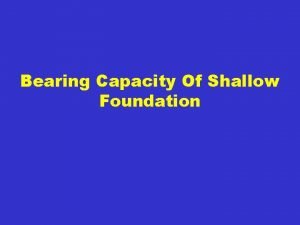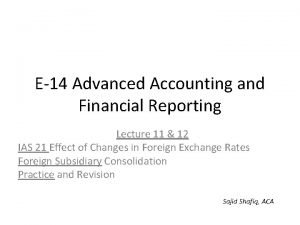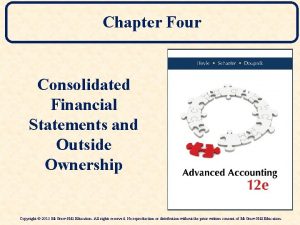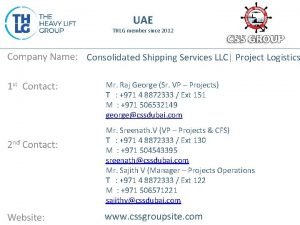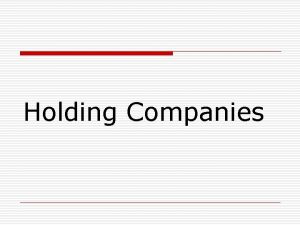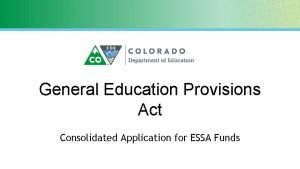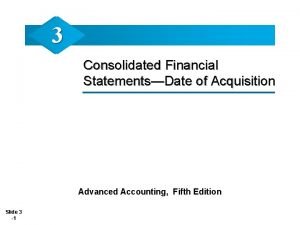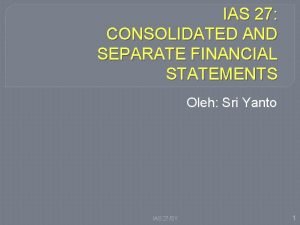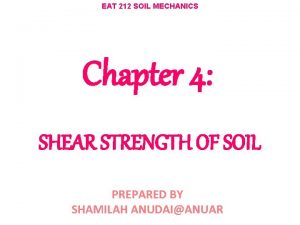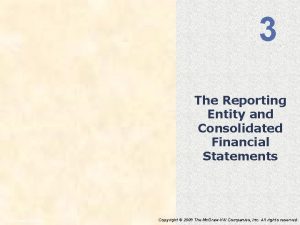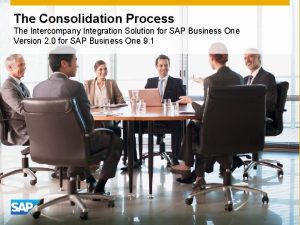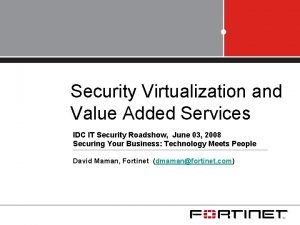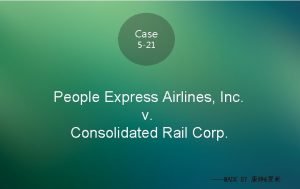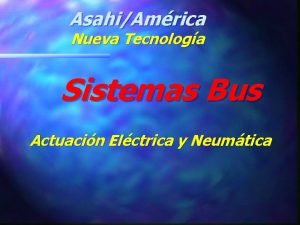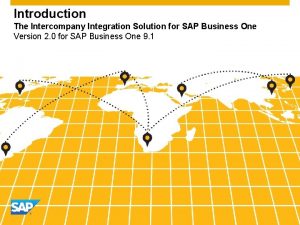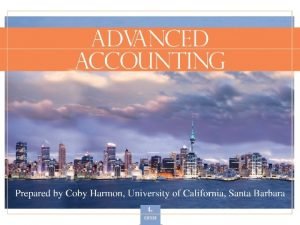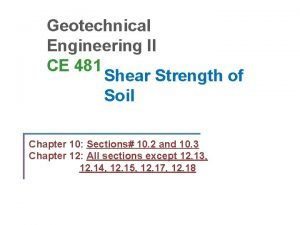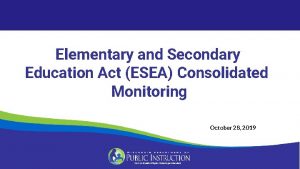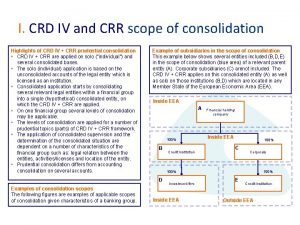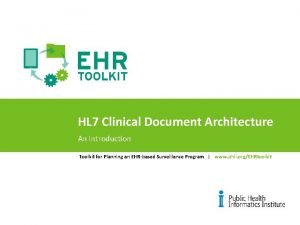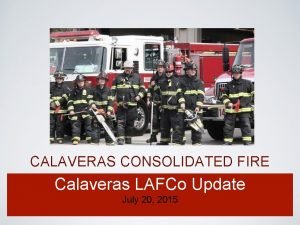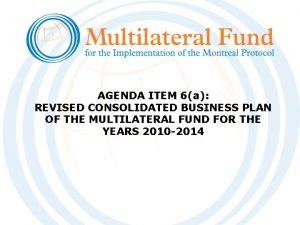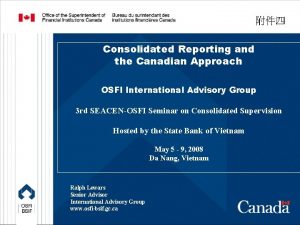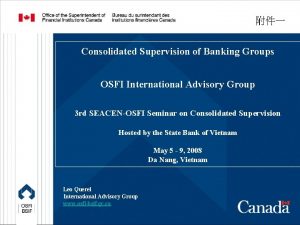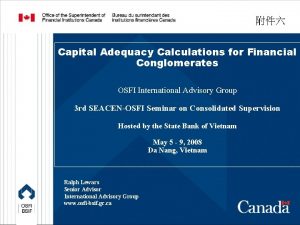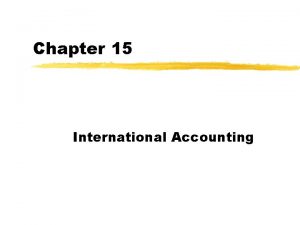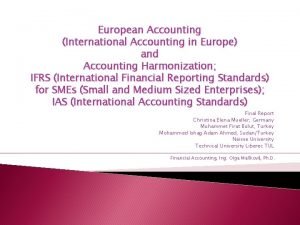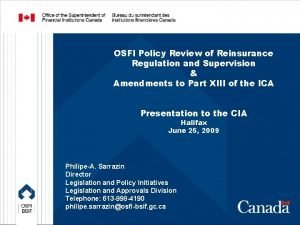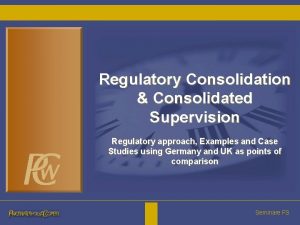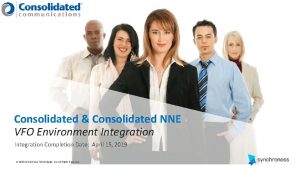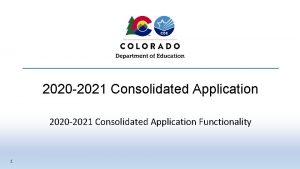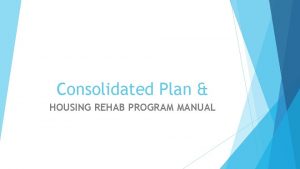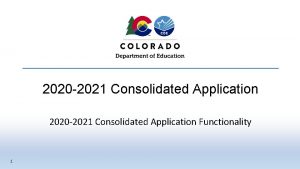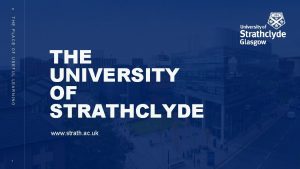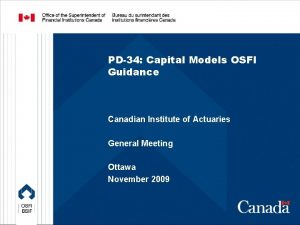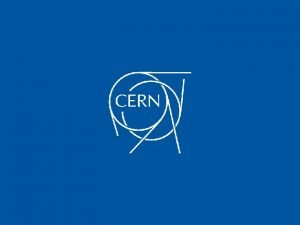Methods of Consolidation and Consolidated Accounting OSFI International































- Slides: 31

附件二 Methods of Consolidation and Consolidated Accounting OSFI International Advisory Group 3 rd SEACEN-OSFI Seminar on Consolidated Supervision Hosted by the State Bank of Vietnam May 5 - 9, 2008 Da Nang, Vietnam Ralph Lewars Senior Advisor International Advisory Group www. osfi-bsif. gc. ca

Discussion Points Methods of Consolidation and Consolidated Accounting ground rules scope • inclusions/exclusions subsidiaries participations • full vs pro rata/proportionate consolidation • equity accounting solo consolidation the Canadian Perspective 2 2

Methods of Consolidation and Consolidated Accounting Ground Rules Consolidated financial statements are KEY to effective supervision Enable supervisors to better measure financial risks of the banking group and apply supervisory standards at the level of the whole banking group 3 3

Methods of Consolidation and Consolidated Accounting Ground Rules Supervisors need to define scope of consolidation – specify the types of entities to be included methods of consolidation – accounting techniques to be used 4 4

Methods of Consolidation and Consolidated Accounting Scope of Consolidation Normal to include only those related entities which carry on activities of a banking or financial nature related entities include subsidiaries and participations, sister banks and financial institutions which are controlled by the same shareholders as the bank itself 5 5

Methods of Consolidation and Consolidated Accounting Scope of Consolidation Risks inherent in non-financial group companies are assessed qualitatively not consolidated and group’s investments in such entities appear as a single asset item 6 6

Methods of Consolidation and Consolidated Accounting Typical Inclusions Non-trading holding companies where the majority of the group are engaged in banking/other financial activities 7 7

Methods of Consolidation and Consolidated Accounting Typical Exclusions Insurance companies given the difference in risks – may not provide a suitable basis for measuring banking risks and applying banking ratios Non-trading holding companies where total assets of the banking/financial entities <50% 8 8

Methods of Consolidation and Consolidated Accounting Typical Exclusions Where control is held by foreign banknot appropriate to consolidate upwards Financial entities established in countries with exchange controls or other regulations preventing repatriation of capital Immaterial subsidiaries – de-minimus exemption 9 9

Methods of Consolidation and Consolidated Accounting Subsidiaries Many countries (including Canada) have accounting regulations which require companies with subsidiaries to publish consolidated financial statements Consolidated financial statements for supervision differ in that they exclude nonfinancial subsidiaries in the group 10 10

Methods of Consolidation and Consolidated Accounting Mechanics Full balance sheet values of the assets/liabilities of the parent company and its subsidiaries are combined on a line-by-line basis All intra-group assets/liabilities are eliminated Share capital of the consolidated subsidiaries excluded to avoid double counting of capital 11 11

Methods of Consolidation and Consolidated Accounting Mechanics Where subsidiaries are <100% owned, the % which belongs to the other minority shareholders is reported as a liability – “minority interests” on the consolidated balance sheet 12 12

Methods of Consolidation and Consolidated Accounting Participations Defined as: the ownership, direct or indirect of 20 % 50% of the voting rights or share capital of an entity, and < 20% where the parent exercises significant influence over the investee’s operations Relationship must be accurately reflected in consolidated financial statements 13 13

Methods of Consolidation and Consolidated Accounting Participations Supervisory concerns Bank may not be able to liquidate quickly without support of other shareholders Bank will not be able to realise its participation by putting investee into voluntary liquidation 14 14

Methods of Consolidation and Consolidated Accounting Participations – Accounting Method - Full vs pro rata consolidation Full consolidation possible – treat as if subsidiary advantage • allows supervisors to see total assets/liabilities over which banking group exercises control/influence 15 15

Methods of Consolidation and Consolidated Accounting Participations - Full vs pro rata consolidation Full consolidation disadvantages: • B/S will include assets/liabilities that parent does not control • existence of a majority of other shareholders will distort the amount of minority interests included in consolidated B/S • full consolidation will overstate amount of capital under its control and allow the group to accumulate excessive assets generally inappropriate 16 16

Methods of Consolidation and Consolidated Accounting Participations - Full vs pro rata consolidation Pro rata consolidation: percentage of investee’s assets/liabilities, equal to the group’s percentage shareholding, is included particularly appropriate for joint ventures 17 17

Methods of Consolidation and Consolidated Accounting Participations - Equity Accounting Widely recognised in national accounting regulations for banks/non-banks Does not reflect the actual amounts of assets/liabilities held through participation Consolidated P&L includes the investing company’s pro rata share of the investee company’s profits 18 18

Methods of Consolidation and Consolidated Accounting Participations - Equity Accounting Consolidated B/S reflects the cost of the participation plus the investing company’s accumulated share of post-acquisition profits or losses Advantage – effect of the influence exercised by the investing company becomes transparent group profits are more meaningful if they reflect fluctuations in a investee company’s profits (i. e. its business performance) rather than merely the variation in dividends 19 19

Methods of Consolidation and Consolidated Accounting Solo Consolidation Used by UK supervisors Assumes it is administratively inefficient to monitor a parent bank separately from controlled/managed subsidiaries Prudential reports fully consolidate assets/liabilities of subs with parent Parent exempted from submitting reports in respect of its own assets/liabilities 20 20

Methods of Consolidation and Consolidated Accounting Solo Consolidation Conditions 75% owned by parent bank wholly funded by parent, no public deposits or all assets represent claims in respect of parent mgmt of subsidiary is under direction of parent bank 21 21

Methods of Consolidation and Consolidated Accounting Solo Consolidation Conditions no potential obstacles to payment of surplus capital aggregate investments of parent bank in solo consolidated subsidiaries do not exceed its own net worth 22 22

Methods of Consolidation and Consolidated Accounting Solo Consolidation Consolidated reports are required which amalgamate the assets/liabilities of the solo consolidated group with those of other consolidated subsidiaries 23 23

Methods of Consolidation and Consolidated Accounting The Canadian Perspective The Bank Act requires that, except as otherwise specified by the Superintendent, the financial statements of a bank shall be prepared in accordance with GAAP Canadian GAAP requires that an enterprise consolidate all subsidiaries 24 24

Methods of Consolidation and Consolidated Accounting The Canadian Perspective - Criteria for Consolidation An entity should consolidate all subsidiaries A company is a subsidiary when it is controlled by another entity that has the right and ability to obtain future economic benefits and is exposed to the related risks 25 25

Methods of Consolidation and Consolidated Accounting The Canadian Perspective - Criteria for Consolidation Control is the continuing power to determine the strategic operating, investing and financing policies without the co-operation of others Ownership of sufficient shares carrying the right to elect the majority of the board is the prime, but not exclusive, evidence of control 26 26

Methods of Consolidation and Consolidated Accounting The Canadian Perspective - Equity Accounting Used where the investor is able to exercise significant influence over an investee without having control e. g. representation on board material inter-company transactions interchange of managerial personnel 27 27

Methods of Consolidation and Consolidated Accounting The Canadian Perspective - Equity Accounting Significant influence is normally evidenced by direct/indirect ownership of 20% 50% of the voting shares Normally included in investment securities in consolidated B/S Bank’s share of earnings is included in interest income from securities in consol. P&L 28 28

Methods of Consolidation and Consolidated Accounting The Canadian Perspective - Equity Accounting Holdings < 20% presumes that significant influence does not exist unless clearly demonstrated otherwise Holdings 20% does not in itself confirm the ability to exercise significant influence 29 29

Methods of Consolidation and Consolidated Accounting The Canadian Perspective – Joint Ventures Should be accounted for by the pro-rata consolidated method Use of equity method is prohibited Full consolidation is not appropriate 30 30

Thank you 31 31
 Soil bearing capacity
Soil bearing capacity Consolidation accounting
Consolidation accounting Consolidation accounting
Consolidation accounting Intercorporate investments
Intercorporate investments Partial equity method consolidation worksheet
Partial equity method consolidation worksheet Consolidated shipping services
Consolidated shipping services Grant hatlen south africa
Grant hatlen south africa Holding companies
Holding companies Gepa statement samples
Gepa statement samples Consolidated financial statements date of acquisition
Consolidated financial statements date of acquisition Ias consolidated financial statements
Ias consolidated financial statements Shear strength in soil mechanics
Shear strength in soil mechanics Parent company theory
Parent company theory Consolidated companies are different sap
Consolidated companies are different sap Noc saga consolidated
Noc saga consolidated Consolidated service center
Consolidated service center People express airlines v consolidated rail corp
People express airlines v consolidated rail corp Abitibi consolidated
Abitibi consolidated Missouri consolidated health care plan
Missouri consolidated health care plan Intercompany sap business one
Intercompany sap business one Business intelligence project plan
Business intelligence project plan Consolidated retained earnings
Consolidated retained earnings Prediction format
Prediction format Intercompany process in sap sd
Intercompany process in sap sd Direct shear test mohr circle
Direct shear test mohr circle Consolidated monitoring
Consolidated monitoring I crd
I crd Clinical document architecture example
Clinical document architecture example Aquifer
Aquifer Consolidated trust
Consolidated trust Calaveras consolidated fire
Calaveras consolidated fire Consolidated business plan
Consolidated business plan
